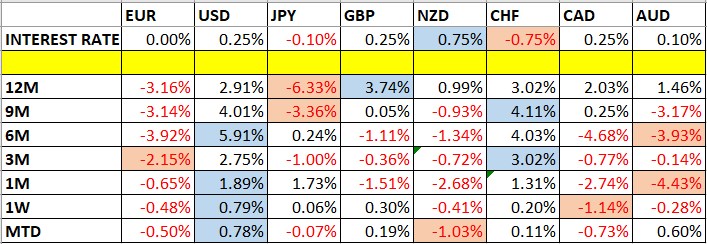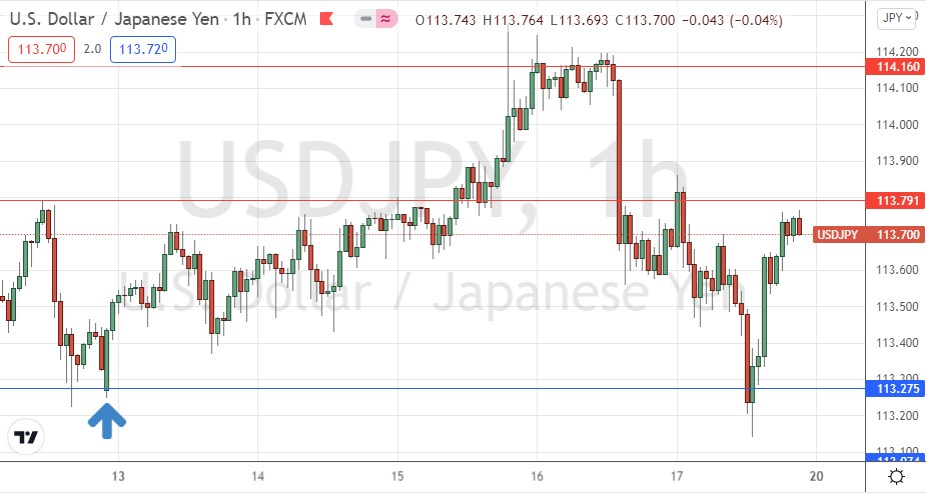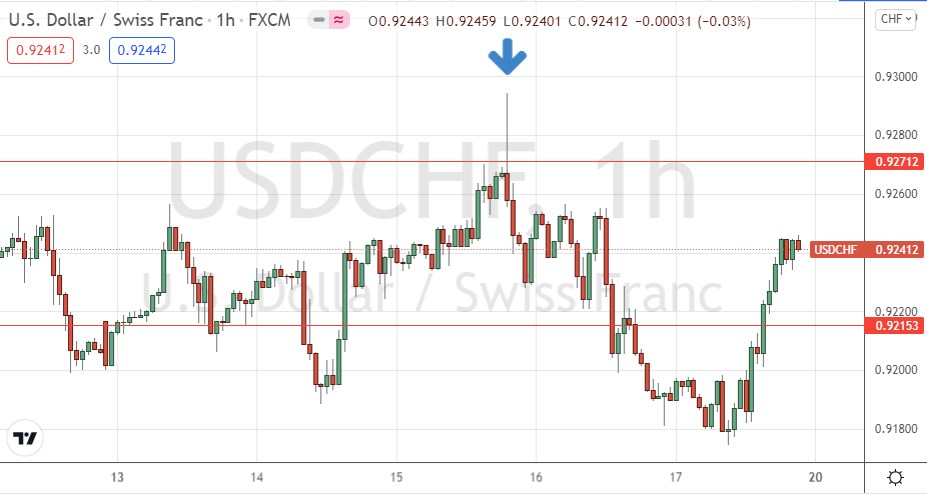This week we will begin with our monthly and weekly forecasts of the currency pairs worth watching. The first part of our forecast is based upon our research of the past 20 years of Forex prices, which show that the following methodologies have all produced profitable results:
Trading the two currencies that are trending the most strongly over the past 3 months.
Assuming that trends are usually ready to reverse after 12 months.
Trading against very strong weekly counter-trend movements by currency pairs made during the previous week.
Carry Trade: Buying currencies with high interest rates and selling currencies with low interest rates.
Let us look at the relevant data of currency price changes and interest rates to date, which we compiled using a trade-weighted index of the major global currencies:

Monthly Forecast December 2021
For the month of December, we forecasted that the GBP/USD and EUR/USD currency pairs would fall in value. The performances to date are shown below:
Currency Pair | Forecast Direction | Interest Rate Differential | Performance to Date |
EUR/USD | Short ↓ | +0.25% (0.25% - 0.00%) | +0.90% |
GBP/USD | Short ↓ | +0.00% (0.25% - 0.00%) | +0.47% |
Weekly Forecast 19th December 2021
In our previous forecast last week, we made no weekly forecast, as although there was an unusually strong counter-trend movements in the AUD/USD currency pair, I did not believe in fading this currency pair short which was unfortunately a bad call. Fading strong weekly counter-trend price movements is the basis of our weekly trading strategy.
We again make no weekly forecast, as there were no strong counter-trend price movements last week in the Forex market.
The Forex market saw a small decrease in its level of directional volatility last week, despite the unusually large amount of high-impact data releases, with only 11% of all the important currency pairs or crosses moving by more than 1% in value. Directional volatility is likely to remain the same or even decrease this week as we wind down into the Christmas holiday schedule.
Last week was dominated by very high relative strength in the US Dollar, and relative weakness in the Canadian Dollar.
You can trade our forecasts in a real or demo Forex brokerage account.
Key Support/Resistance Levels for Popular Pairs
We teach that trades should be entered and exited at or very close to key support and resistance levels. There are certain key support and resistance levels that can be watched on the more popular currency pairs this week.
Currency Pair | Key Support / Resistance Levels |
AUD/USD | Support: 0.7083, 0.7051, 0.6963, 0.6926 Resistance: 0.7148, 0.7271, 0.7302, 0.7321 |
EUR/USD | Support: 1.1229, 1.1195, 1.1155, 1.1089 Resistance: 1.1281, 1.1296, 1.1394, 1.1456 |
GBP/USD | Support: 1.3141, 1.3079, 1.3005, 1.2785 Resistance: 1.3273, 1.3304, 1.3414, 1.3523 |
USD/JPY | Support: 113.07, 111.55, 111.23, 111.06 Resistance: 114.28, 114.53, 115.25, 116.29 |
AUD/JPY | Support: 80.50, 79.81, 78.59, 78.14 Resistance: 81.30, 81.49, 82.68, 84.14 |
EUR/JPY | Support: 127.44, 126.88, 126.65, 126.43 Resistance: 128.56, 128.97, 129.56, 130.03 |
USD/CAD | Support: 1.2813, 1.2733, 1.2680, 1.2637 Resistance: 1.2901, 1.2959, 1.2990, 1.3000 |
USD/CHF | Support: 0.9200, 0.9072, 0.9000, 0.8969 Resistance: 0.9271, 0.9370, 0.9387, 0.9438 |
Let us see how trading reversals from two of last week’s key levels could have worked out:
USD/JPY
We had expected the level at 113.28 might function as support, as it had acted previously as both support and resistance. Note how these “flipping” levels can work well. The H1 chart below shows how the price started the week immediately with a large bullish hourly candlestick during the first Asian session, typically a great time to enter new trades in currency pairs and crosses involving the Japanese Yen, marked by the up arrow in the price chart below as it rose from the support level. This trade was nicely profitable, achieving a maximum positive reward to risk ratio of more than 3 to 1 based upon the size of the entry candlestick.
USD/CHF
We had expected the level at 0.9271 might function as resistance, as it had acted previously as both support and resistance. Note how these “flipping” levels can work well. The H1 chart below shows how the price rejected this level with a very large, bearish pin candlestick just after last week’s FOMC release, often a good time to enter a new trade in a major Forex currency pair involving the US Dollar, marked by the down arrow in the price chart below. This trade has been profitable so far, achieving a maximum positive reward to risk ratio of almost 2 to 1 based upon the size of the entry candlestick.
That is all for this week. You can trade our forecasts in a real or demo Forex brokerage account to test the strategies and strengthen your self-confidence before investing real funds.



